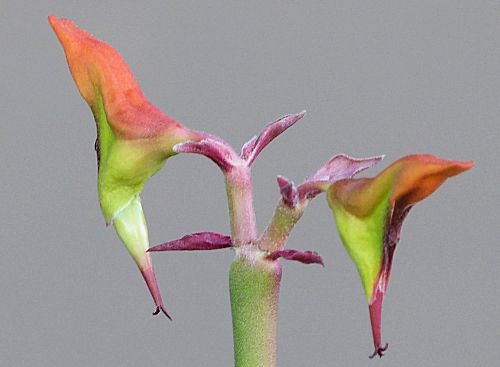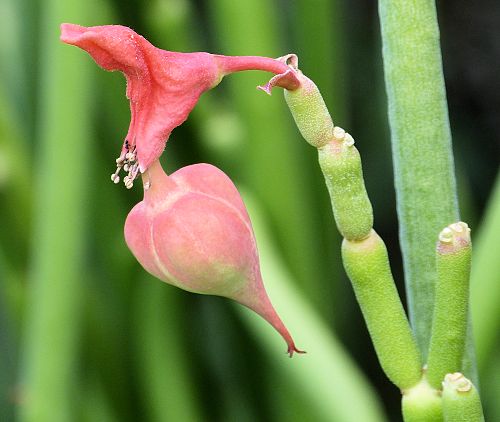Growing Euphorbia lomelii:
Slipper Plant
Former scientific name - Pedilanthus macrocarpus
Description
Form: A long-stemmed succulent with a woody root crown.
Lifespan: Perennial.
Leaf retention: Deciduous.
Growth rate: Slow.
Mature Size: 3-6' (1-2m) high and wide.
Flowers: Red bracts, oddly shaped like a slipper or hummingbird, contain one female and several male flowers.
Bloom: Spring into fall.
Fruit: Seed capsule.
Leaves: Tiny, with a narrow pointed spade shape, red turning to green or yellow or brown, appearing after rain, dropping within weeks, often missing.
Stems: Green, jointed, mostly unbranched, upright and straight, or undulating, coated with wax, photosynthesizing. The stems may become reddish when exposed to temperatures in the thirties and forties (-1 to 10°C) over several weeks. New stems rise from the edges of the root crown.
Wildlife: The flowers attract hummingbirds. It is ignored by insects because they cannot access the nectar.
Toxic / Danger: The sap may irritate skin and will cause an upset stomach.
Origin: The Sonoran Desert of Baja California and Sonora counties, Mexico.
Form: A long-stemmed succulent with a woody root crown.
Lifespan: Perennial.
Leaf retention: Deciduous.
Growth rate: Slow.
Mature Size: 3-6' (1-2m) high and wide.
Flowers: Red bracts, oddly shaped like a slipper or hummingbird, contain one female and several male flowers.
Bloom: Spring into fall.
Fruit: Seed capsule.
Leaves: Tiny, with a narrow pointed spade shape, red turning to green or yellow or brown, appearing after rain, dropping within weeks, often missing.
Stems: Green, jointed, mostly unbranched, upright and straight, or undulating, coated with wax, photosynthesizing. The stems may become reddish when exposed to temperatures in the thirties and forties (-1 to 10°C) over several weeks. New stems rise from the edges of the root crown.
Wildlife: The flowers attract hummingbirds. It is ignored by insects because they cannot access the nectar.
Toxic / Danger: The sap may irritate skin and will cause an upset stomach.
Origin: The Sonoran Desert of Baja California and Sonora counties, Mexico.
Cultivation and Uses
USDA hardiness zones: 10-11 for new stem growth which is severely damaged below 30°F (-1.1°C). 9b-11 for old growth which is hardy to 25°F (-3.9°C) and may withstand brief periods to 20°F (-6.7°C).
Heat tolerant: Yes.
Drought tolerant: Yes.
Sun: Full sun to part shade. This plant needs direct sun to flower, and more sun produces more flowers. In its native habitat, it may be partially shaded by other desert plants.
Soil: Very well draining, dry, low in organic content, pH 6.1-8.5 (slightly acidic to alkaline). In other words, ordinary desert soil.
Fertilize: No. This plant is adapted to the poor quality soil of the desert.
Water once established: Once a month to weekly depending on location, temperature, and pot size.
Planting: It is easily grown in containers that are very well draining. Containers can be moved inside in the winter to avoid freezes. It can be grown in USDA zone 9a next to a wall facing south or southwest.
Prune: Any time of year. It handles pruning well once established.
Litter: Low.
Propagation: Root division, cuttings, or seed. For cuttings, once the cut end has dried in the shade, put it into well draining soil. Water lightly every three days, letting the soil dry completely between waterings. Gradually decrease watering to every two weeks.
Uses: Accent plant, low water (xeriscape) garden.
USDA hardiness zones: 10-11 for new stem growth which is severely damaged below 30°F (-1.1°C). 9b-11 for old growth which is hardy to 25°F (-3.9°C) and may withstand brief periods to 20°F (-6.7°C).
Heat tolerant: Yes.
Drought tolerant: Yes.
Sun: Full sun to part shade. This plant needs direct sun to flower, and more sun produces more flowers. In its native habitat, it may be partially shaded by other desert plants.
Soil: Very well draining, dry, low in organic content, pH 6.1-8.5 (slightly acidic to alkaline). In other words, ordinary desert soil.
Fertilize: No. This plant is adapted to the poor quality soil of the desert.
Water once established: Once a month to weekly depending on location, temperature, and pot size.
Planting: It is easily grown in containers that are very well draining. Containers can be moved inside in the winter to avoid freezes. It can be grown in USDA zone 9a next to a wall facing south or southwest.
Prune: Any time of year. It handles pruning well once established.
Litter: Low.
Propagation: Root division, cuttings, or seed. For cuttings, once the cut end has dried in the shade, put it into well draining soil. Water lightly every three days, letting the soil dry completely between waterings. Gradually decrease watering to every two weeks.
Uses: Accent plant, low water (xeriscape) garden.
Comments
This plant is a member of the Spurge family (Euphorbiaceae). Another common name is Lady's Slipper.
The best way to prevent this plant from flowering is to [1] fertilize it, [2] keep it away from direct sunlight, [3] water it more than once a week after it is established, or [4] keep it in wet, poorly draining soil. In its native, sunny, hot, very dry, very poor soil desert, monthly rain is a treat.
This plant is sometimes confused with Euphorbia tirucalli, Fire Sticks, a highly toxic, highly invasive plant that is difficult to control. But Fire Sticks stems are divided into many branches, especially at top, and are normally colored orange or red on the top sections while being green at the bottom. Euphorbia lomelii stems seldom branch and tend to be green from top to bottom.
A separate species, Euphorbia bracteata, is also called Slipper Plant, even though its flower bracts are clamshell-shaped. It has similar stems, but larger, oval, more persistent green leaves. It prefers open shade and likes to avoid full or part sun.
Do you have additional information or a different experience for these plants that you would like to share? Email info@GardenOracle.com. All contributions are welcome and appreciated.
This plant is a member of the Spurge family (Euphorbiaceae). Another common name is Lady's Slipper.
The best way to prevent this plant from flowering is to [1] fertilize it, [2] keep it away from direct sunlight, [3] water it more than once a week after it is established, or [4] keep it in wet, poorly draining soil. In its native, sunny, hot, very dry, very poor soil desert, monthly rain is a treat.
This plant is sometimes confused with Euphorbia tirucalli, Fire Sticks, a highly toxic, highly invasive plant that is difficult to control. But Fire Sticks stems are divided into many branches, especially at top, and are normally colored orange or red on the top sections while being green at the bottom. Euphorbia lomelii stems seldom branch and tend to be green from top to bottom.
A separate species, Euphorbia bracteata, is also called Slipper Plant, even though its flower bracts are clamshell-shaped. It has similar stems, but larger, oval, more persistent green leaves. It prefers open shade and likes to avoid full or part sun.
Do you have additional information or a different experience for these plants that you would like to share? Email info@GardenOracle.com. All contributions are welcome and appreciated.



Latest update: March, 2024
© 2008-2025 by GardenOracle.com

